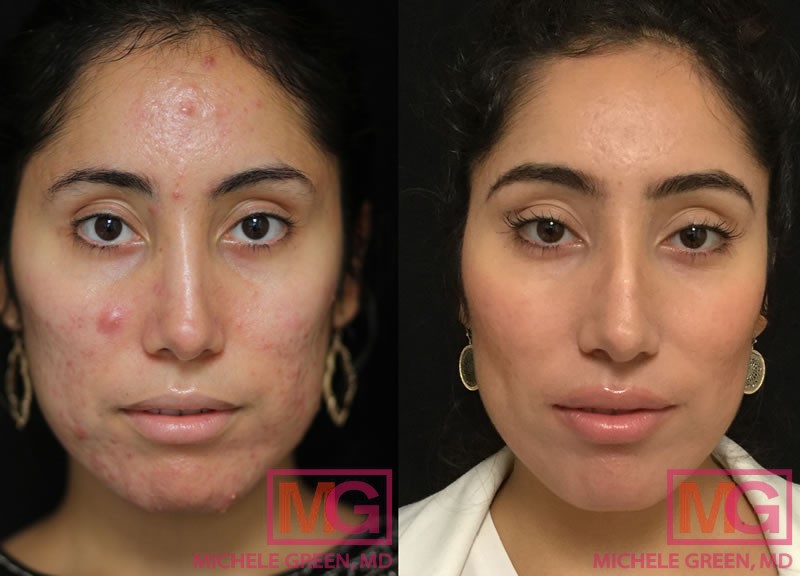Subcision for Acne Scarring
Subcision for acne scar treatment is one of the most popular procedures in the private NYC dermatology office of Dr. Michele Green. Acne scars are the result of acne which has not healed properly, leaving the skin affected. Acne is one of the most common skin conditions in the United States, affecting as many as 50 million Americans every year. Severe inflammatory acne breakouts, including cysts, papules, and pustules, can develop into acne scars when left untreated, which can be harder to get rid of than the original breakout. Depending on how the skin heals, acne breakouts can develop into atrophic scars, which are characterized by depressions on the skin’s surface formed when insufficient collagen is produced during the healing process; hypertrophic scars, which are characterized by raised scars that form due to excess collagen production during healing; and hyperpigmentation or discoloration on the skin’s surface. The appearance of acne scars is permanent without treatment and can make many patients feel self-conscious. Luckily, expert board-certified dermatologist Dr. Michele Green in NYC is an expert in removing acne scars and treatment options available to address all forms of acne scarring.
Patients dealing with atrophic acne scars can consider subcision acne scar treatment—a minor surgical procedure designed to reduce depressions in the skin’s surface. Also known as subcutaneous incision-less surgery, subcision is particularly effective for two specific types of atrophic scars: boxcar scars, which are round or oval-shaped depressions, and rolling scars, which create a wavy, uneven appearance in the skin. Subcision operates by using a hypodermic needle to sever the fibrous bands in the underlying tissue, resulting in an immediate lift of the skin and enhancing the body’s natural collagen production, leading to smoother skin over time. When combined with supplementary in-office treatments like dermal fillers, microneedling, chemical peels, TCA cross, CO2 laser resurfacing, fractionated laser resurfacing, or radiofrequency laser therapy, subcision becomes a highly effective treatment option for atrophic scars.
Dr. Michele Green, based in New York City, is an internationally recognized, board-certified dermatologist with over 25 years of experience. She provides discerning men and women with the finest skincare and minimally invasive cosmetic treatment options, such as subcision for acne scars. Dr. Green’s dedication to her patients and her expertise have earned her consistent recognition as one of New York’s top dermatologists by Castle Connolly, New York Magazine, and Super Doctors. She adopts a holistic approach to facial rejuvenation and embraces a ‘less is more’ philosophy, tailoring each treatment plan to integrate a unique combination of specially formulated skincare products and in-office options that best address the specific concerns and overall aesthetic goals of each patient.
What is subcision acne scar treatment?
Subcision for acne scar treatment, also known as subcutaneous incision-less surgery, is a safe and effective option for treating depressed acne scars. Although subcision is classified as a surgical procedure, it does not involve making cuts on the skin’s surface. Instead, a gauge needle, Nokor needle, or hypodermic needle is inserted into the dermis directly beneath the atrophic scar to break the fibrotic strands that connect the skin’s surface to the underlying scar tissue. This method immediately lifts the skin and initiates the body’s natural healing response, promoting collagen production over time. While primarily used to treat depressed acne scars, the treatment can also help reduce the visibility of wrinkles and cellulite on the face and body. Typically, multiple treatment sessions are necessary to achieve optimal results.
What type of acne scars need subcision?
There are two overarching types of acne scars: atrophic and hypertrophic. Both types are formed due to varying levels of collagen production during the healing process. Atrophic scars, which are caused by insufficient collagen production, leave depressions on the surface of the skin. There are three subtypes of atrophic scars: ice-pick scars, boxcar scars, and rolling scars.
- Icepick scars form when an infected breakout occurs deep under the surface of the skin. They are often small, deep, and narrow. Due to their depth, icepick scars can be difficult to treat.
- Boxcar scars are characterized by shallow, wide, oval, or circular depressions on the skin’s surface. They form when inflammatory acne destroys the fibrous bands of collagen in the skin, leaving a depression due to a lack of tissue support.
- Rolling scars create a wavy appearance on the outer layer of skin. They are often shallow and caused by fibrous bands under the surface of the skin pulling unevenly on the epidermis.
Hypertrophic scars, on the other hand, are caused by an over-production of collagen during the healing process, leading to a raised appearance of the scar tissue. For hypertrophic scars, collagen-inducing treatments, such as microneedling, are not advised.
Subcision is best for treating boxcar scars and rolling scars. Both types of acne scars form when fibrous bands pull on the skin’s surface, causing depressions. Subcision treatment Subcision is most effective for treating boxcar and rolling scars. Both types of acne scars occur when fibrous bands pull on the skin’s surface, resulting in depressions. This treatment aims to detach the fibrotic strands from the underlying scar tissue, lifting the skin for a smoother appearance. However, subcision is not considered an ideal treatment for most ice-pick scars, hypertrophic scars, or keloid scars.
How does subcision work?
During subcision treatment, a small needle is used to break apart the fibrous strands of scar tissue that tether the top layer of skin to the underlying tissue. Once the fibrous bands are disrupted, the skin is encouraged to produce new collagen and elastic fibers, allowing the area to heal with a smoother, more even skin texture. When performed with dermal fillers, the filler is then injected into the depressed scar to replace the lost volume and correct its depressed appearance. Dr. Green’s unique technique of subcision and dermal filler injection allows for enhanced results after a single treatment.
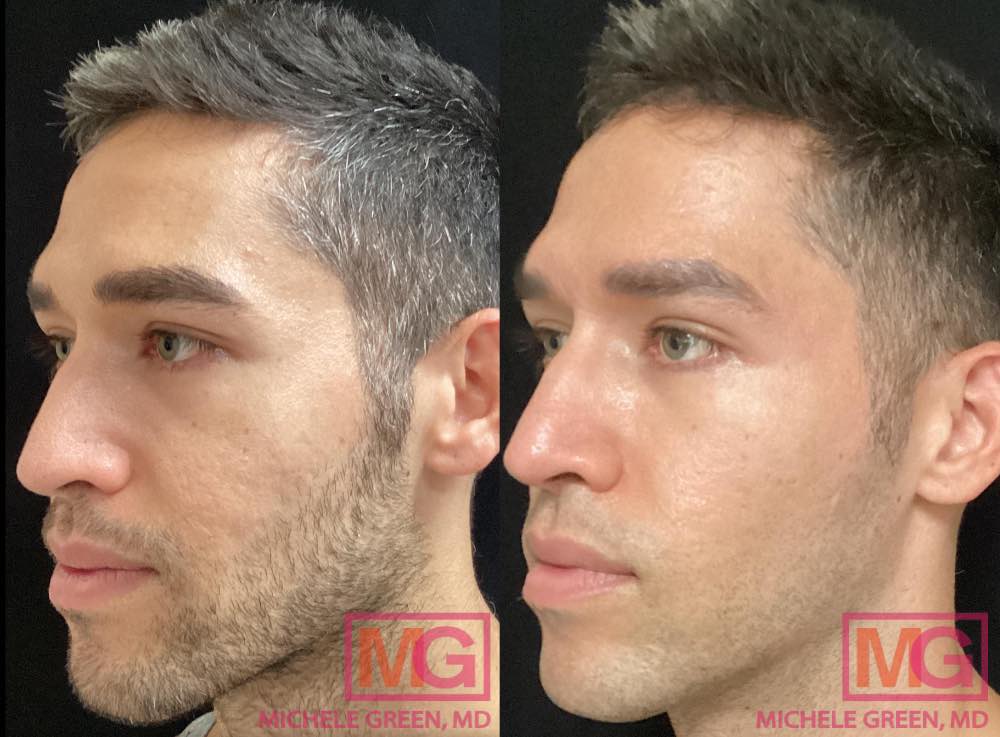
What is the procedure for subcision treatment at a dermatology office?
The first step for any kind of acne scar treatment is to schedule a consultation with expert dermatologist Dr. Michele Green. It is essential to choose a board-certified dermatologist, such as Dr. Green, to reduce the risk of unwanted side effects for a surgical procedure like subcision. Dr. Green will begin by examining the treatment area and discussing your aesthetic goals to determine the treatment or series of treatments that will be best for you. If subcision is the right option, Dr. Green will instruct patients to apply a local anesthetic cream one hour before the treatment session. A topical numbing cream will help to reduce potential discomfort during the procedure.
The treatment area will be marked with a surgical pen before the surgery begins. Then, Dr. Green will insert an 18 or 20-gauge needle or cannula at an acute angle next to the scar, with the bevel of the needle pointed upwards and parallel to the skin’s surface. The needle is moved in a fanning motion within the dermis to break up the scar tissue and fibrous bands. Patients will immediately experience a lifting of the skin, creating a more even skin texture. Over time, new collagen production will lead to smoother, tighter skin. Minimal downtime is required after the procedure, and patients should expect to heal fully within a week.
What are the side effects of subcision treatment?
Subcision is a safe and effective treatment option for atrophic scars when conducted by a skilled board-certified dermatologist like Dr. Green. This treatment has minimal downtime and is associated with mild side effects, such as bruising, swelling, and tenderness at the treatment site. These common side effects typically resolve without intervention within a week after the procedure. To minimize the risk of bruising, Dr. Green advises patients to avoid taking blood thinners and anti-inflammatory medications, such as Advil, Motrin, and Aleve, one week prior to the treatment.
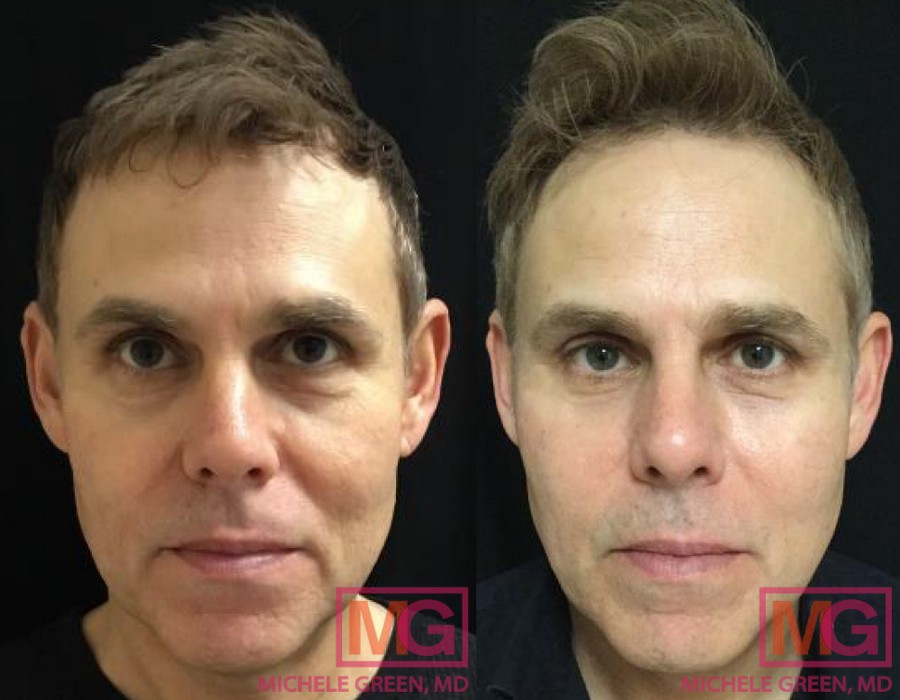
Is acne scar subcision treatment the best treatment option?
Acne scar subcision treatment stands out as one of the most effective options for treating depressed acne scars, particularly boxcar scars and rolling scars. Some patients may achieve better outcomes by combining subcision with other in-office treatments, such as dermal fillers, laser resurfacing, radiofrequency laser therapy, microneedling, or chemical peels. Depending on the size and nature of the treatment area, as well as each patient’s unique skin type and aesthetic goals, Dr. Green will recommend the most effective and safest series of treatments.
- Dermal fillers – One of the treatment options that Dr. Green most frequently pairs with subcision for acne scar treatment is dermal fillers, such as Juvederm, Restylane, and Sculptra. Dermal fillers are injectable treatments designed to restore lost volume, making them ideal for treating atrophic acne scars (depressed scars), where a loss of collagen has created depressions in the surface of the skin. The treatment works by injecting the filler into the depressed scars, which instantly restores lost volume to the area and triggers additional collagen production, resulting in firmer, smoother skin that lasts.
- Laser Treatment such as Fraxel and eMatrix – Dr. Green may recommend laser treatment alongside acne scar subcision to enhance the tone and texture of the skin in the treatment area. Numerous laser treatment options are available, including Fraxel, Vivace, eMatrix, and Clear + Brilliant lasers. During your consultation, Dr. Green will determine the most suitable laser treatment for you based on your skin type, skin tone, and specific concerns. The Fraxel laser works to diminish the appearance of acne scars by creating a series of microscopic wounds using concentrated laser pulses. These wounds stimulate the body’s natural healing process, boosting collagen production and improving the appearance of acne scars over 5 to 6 treatment sessions. The Vivace laser combines radiofrequency technology with microneedling to encourage collagen production and enhance skin texture. Both the eMatrix and Clear + Brilliant lasers are suitable for all skin types, including those with darker skin, without the risk of hyperpigmentation. The eMatrix employs bi-polar radiofrequency to enhance skin tone and texture, while the Clear + Brilliant laser functions similarly to a mini Fraxel laser, utilizing fractionated laser technology to promote collagen production and reduce pigmentation in the skin.
- VBeam Laser –The VBeam laser is ideally used for treating broken blood vessels and reducing redness associated with acne scarring or post-inflammatory hyperpigmentation. This laser employs pulsed dye technology with a 595-nanometer wavelength to target blood vessels and red pigments in the skin, effectively diminishing visible redness at the site of acne and surgical scars. Once the blood vessels are treated, the appearance of the scars improves. Additionally, VBeam laser treatment can stimulate new collagen production and flatten the skin in the affected area. Multiple sessions are necessary to enhance the appearance of acne scars.
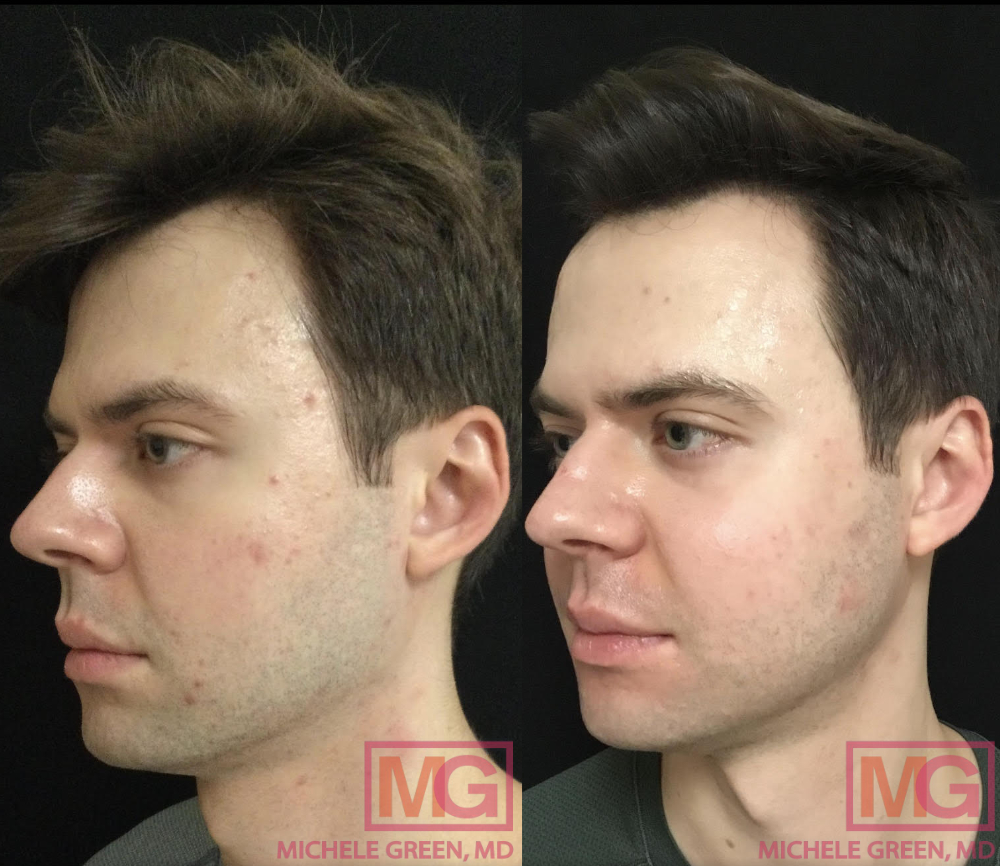
VBeam and eMatrix for Acne Scars before and after
- TCA Cross – Trichloroacetic acid (TCA) cross is a chemical solution applied directly to atrophic acne scars to boost collagen and elastin production for firmer, smoother skin. This acne scar treatment is effective for icepick scars, rolling acne scars, and boxcar scars, with the aim of raising the skin and reducing the visibility of depressed scars. However, this treatment should be avoided for patients with darker skin tones due to a higher risk of unwanted side effects, such as hyperpigmentation.
- Chemical Peels – Chemical peels are non-invasive resurfacing treatments used to improve overall skin texture and tone. Chemical peels use chemical exfoliants to stimulate collagen production and accelerate skin cell turnover, sloughing off dead skin cells to reveal healthy new cells underneath. Chemical peels can be superficial or light, medium-depth, or deep. Dr. Green will often opt for a superficial or medium-depth peel, depending on the severity of the acne scarring. Trichloroacetic acid (TCA) peels are excellent for sloughing off dead skin cells to gently resurface the skin and improve the appearance of depressed acne scars. Mesopeels are chemical peels that use skin-brightening ingredients like tranexamic acid to treat post-inflammatory hyperpigmentation from past acne lesions. Often, a series of three to six chemical peels are recommended to see the best acne scar improvement with treatment.
- Microneedling – Microneedling, also referred to as collagen induction therapy, is a non-invasive cosmetic procedure used to improve the appearance of acne scars, uneven texture, fine lines, wrinkles, and pore size. During treatment, tiny surgical-grade needles are used to create micro-injuries in the epidermis, triggering the skin’s natural wound-healing process and the production of new collagen. The microchannels created also allow for increased absorption of topical products, allowing for the procedure to be enhanced with targeted serums. Patients experiencing post-inflammatory hyperpigmentation from acne scars can incorporate a depigmentation serum during treatment to gradually lighten acne scars and even out skin tone. Patients can also incorporate platelet-rich plasma (PRP), which contains an abundance of growth factors and proteins to accelerate new collagen production for faster and more effective results. PRP is derived from the patient’s blood, making it 100% safe to use during the microneedling procedure. Patients typically need a series of at least three microneedling sessions spaced one month apart for optimal results.
What is Microneedling for acne scars?
Microneedling is another acne scar treatment option that improves the texture of the skin’s surface by creating micro-injuries in the epidermis, triggering the natural wound-healing process of the skin, which boosts the body’s natural collagen and elastin production. Through the use of a handheld device with surgical-grade needles, microscopic wounds are created on the surface of the skin in the treated area. Microneedling is often paired with Platelet Rich Plasma (PRP), which helps to increase the body’s production of collagen for even better results and faster healing. A series of microneedling sessions are needed for the best cosmetic results for acne scars.
Do fillers work for acne scar treatment?
Yes, dermal fillers are incredibly effective for treating depressed acne scars. These scars form due to insufficient collagen production during the healing process. Dermal fillers work to replace lost volume, smooth the skin, and stimulate collagen production in the injected area. Fillers can be injected into isolated scars or in a larger area, such as the cheeks or temples, to reduce the appearance of volume loss and create a smoother-looking appearance. Dr. Green often pairs dermal fillers with subcision to break apart the scar tissue underneath for the most optimal results. Common dermal fillers used for acne scar treatment include Sculptra, Juvederm, and Restylane.
Sculptra is a unique dermal filler composed of a substance called poly-L-lactic acid, which stimulates new collagen production in the treated area once injected. Over time, as new collagen is produced, the skin texture becomes smoother, reducing the appearance of depressed scars. A short series of three Sculptra treatment sessions is usually required to achieve optimal results. It takes 4 to 6 weeks to see the effect of each Sculptra treatment, and results last up to two years. Most patients engage in regular follow-up treatment sessions on an annual basis to maintain ideal results.
Subcision with hyaluronic acid dermal fillers like Juvederm and Restylane is another effective acne scar treatment option. Hyaluronic acid is a naturally occurring substance in the skin that contributes to hydration and a youthful appearance. These dermal fillers are also often used to reduce wrinkles, restore lost volume, and enhance certain facial features. Hyaluronic acid fillers provide immediate results that tend to last 6-18 months. This subcision technique is highly effective since you have the immediate benefit of restoring volume to these scars via the injectable filler and the long-term effect of producing new collagen for lasting rejuvenation. When you consult with Dr. Green at her private dermatology office in NYC, she will physically evaluate your skin condition and review your particular skin concerns and aesthetic goals to create a customized acne scar treatment plan best suited to you.
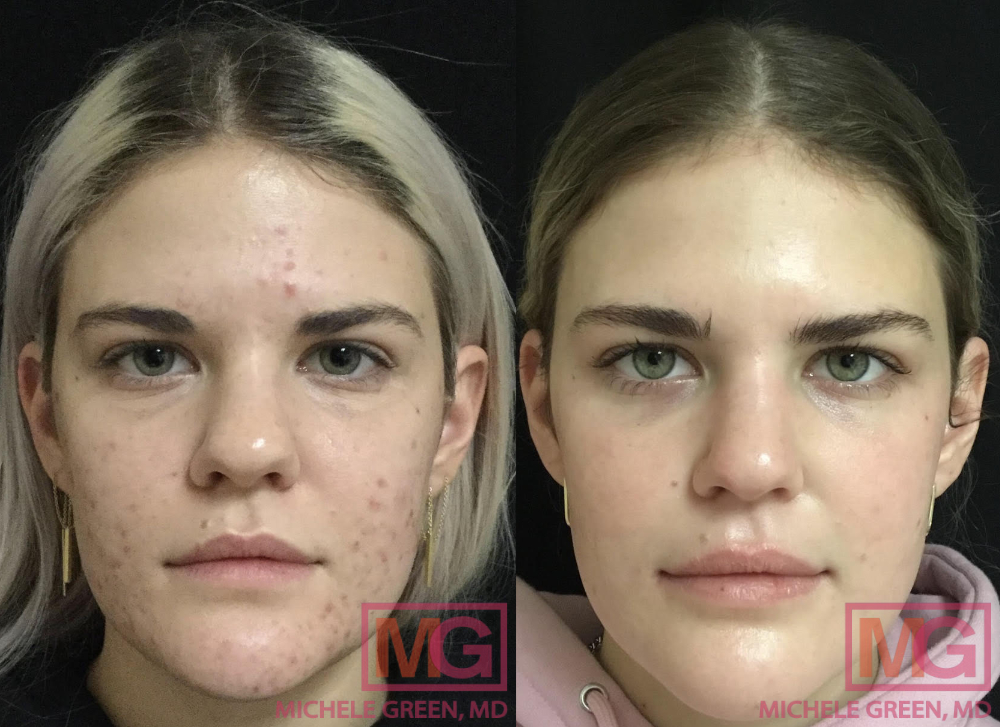
FAQs for subcision acne scar treatment
Is microneedling better than subcision for acne?
Microneedling and subcision are both effective treatment options for reducing the appearance of acne scars. Microneedling triggers the skin’s natural wound-healing process to increase new collagen production, improving skin texture and the appearance of fine lines and wrinkles. Subcision is a procedure that breaks apart scar tissue underneath depressed acne scars and is often paired with dermal fillers to reduce volume loss for a smoother skin texture. Microneedling is best suited for patients with skin texture irregularities looking to improve the appearance of mild to moderate acne scars. Subcision with dermal fillers is best suited for patients experiencing volume loss from depressed acne scars. As patients often have a wide variety of acne scars on their skin, Dr. Green often employs a combination of procedures in her patient’s acne scar treatment plans to achieve a clear, smooth complexion. When you have your initial consultation with Dr. Green, she will help you to determine the treatment option that will be most effective for you.
Does microneedling or subcision get rid of acne scars permanently?
Subcision works via the insertion of a hypodermic needle that is moved around in a fanning motion to break up the fibrous bands, tethering the skin’s surface to the underlying tissue. Once the fibrotic strands are broken, there is an immediate “lifting” to the skin, reducing the appearance of depressed acne scars and creating smoother-looking skin. Results will continue to improve over time as the procedure also boosts collagen production, which further helps to improve skin texture. The results of the subcision are permanent, as the fibrotic strands that form the scar tissue are destroyed. The collagen production results of microneedling are also long-lasting. However, collagen production in the body will continue to decrease over time, meaning that repeat treatment sessions may be necessary to maintain treatment results.
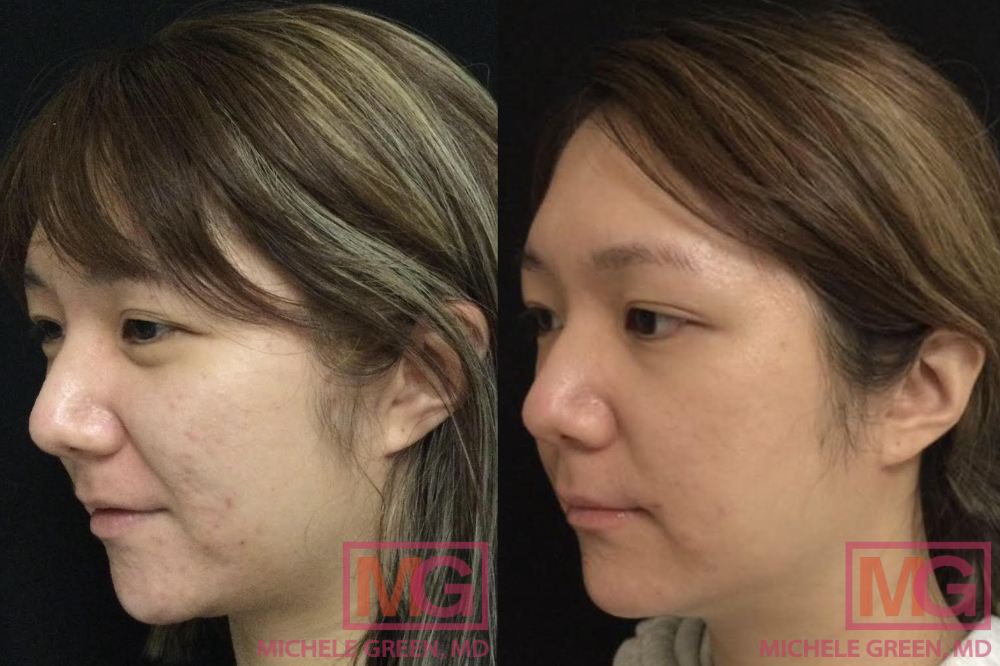
Is one subcision session enough for acne?
Although some patients may see a difference after only one treatment session, multiple sessions are needed for the best results. Dr. Green recommends that patients with moderate to severe acne scars receive between three and six treatment sessions, each spaced four to six weeks apart. The cosmetic results will last once the full round of treatments has been completed.
What is the success rate of subcision?
Subcision acne scar treatment is a permanent procedure designed to eliminate the appearance of depressed acne scars. The treatment works to induce the body’s natural wound-healing process, which in turn produces new collagen for a natural and permanent solution to acne scarring. While the long-term effects of acne scar subcision have not yet been extensively studied, several small-scale studies have demonstrated the accessibility and longevity of the treatment, including a 2010 study published by the National Institute of Health. The International Journal of Research in Medical Sciences published research in 2016 demonstrating that out of three common acne scar treatments, subcision, CO2 fractional lasers, and derma rollers, subcision was the most successful at treating acne scars.
How much does acne subcision cost?
The price for acne scar treatment with subcision varies depending on a number of factors involved with the treatment. The experience level of the physician who is performing the procedure, the geographic location of the medical office where you are treated, and the severity of the acne scars requiring treatment will all influence the total cost of your treatment. Patients with more severe acne scars will likely require more subcision treatment sessions. Additionally, when dermal fillers are utilized in tandem with the subcision procedure, the cost of the Juvederm, Restylane, or Sculptra products will be factored into the total treatment cost, varying depending on how much of the dermal filler product is needed. It’s important to choose a provider with adequate knowledge, experience, and exceptional skill to perform your subcision treatment to ensure that you have outstanding cosmetic results. During your consultation with Dr. Green, it will be determined which type and what quantity of dermal fillers will best complement your subcision procedure and the total cost discussed.
Does insurance cover subcision?
Typically, insurance companies will not cover acne scar subcision because it is considered a cosmetic treatment. It is best to contact your insurance company to determine what procedures may be covered.
Do MedSpas do subcision?
Typically, MedSpas cannot perform subcision, as the procedure requires expertise and knowledge of facial anatomy to be performed correctly. Only a board-certified dermatologist such as Dr. Michele Green should perform an acne scar subcision. Improper technique can result in unwanted cosmetic results and adverse side effects such as scarring and infection. Dr. Michele Green has over 25 years of experience performing subcisions to treat her patients’ acne scars, and she will ensure that your subcision procedure is both safe and effective to leave you with a beautiful, smooth complexion that lasts.
How painful is acne subcision?
Subcision acne scar treatment is not associated with a significant amount of pain or discomfort. An hour before acne scar subcision treatment, Dr. Green will have patients apply a topical local anesthetic to numb the treatment area and reduce the risk of discomfort. The numbing cream should be applied on recently cleaned skin and will be cleaned off right before the procedure. Most patients do not experience any significant discomfort during the treatment. Downtime is minimal, and the most common side effects, including bruising, swelling, and tenderness, are typically mild and resolve within one week.
How long does it take for a subcision to heal?
Subcision acne scar treatment is a minor surgical procedure with minimal downtime and a short recovery window. In the days following the treatment, patients may experience some mild side effects, including bruising, swelling, and tenderness at the treatment site. However, these side effects will resolve on their own within one week. Most patients find that they are fully healed from the procedure one week after the treatment session.
Does subcision really work for acne scars?
Yes. Subcision is an effective treatment for depressed acne scars, specifically boxcar scars and rolling scars. Researchers have demonstrated that subcision treatment can help to reduce the appearance of acne scars permanently. One study showed that 90% of Yes. Subcision is an effective treatment for depressed acne scars, particularly boxcar scars and rolling scars. Researchers have shown that subcision can help permanently reduce the appearance of acne scars. One study found that 90% of participants experienced a noticeable improvement in their skin texture after subcision treatment. Results may be enhanced when subcision is combined with other options, such as dermal fillers or laser resurfacing. To discover the best treatment combination for you, schedule your initial consultation with Dr. Green.
How to get started with subcision acne scar treatment today
Acne scars can be challenging to treat, and many patients may feel self-conscious about their appearance. Fortunately, there are numerous effective treatment options for acne scar revision available at the private dermatology office of Dr. Michele Green in New York City, including subcision with dermal fillers for acne scar treatment. If you are concerned about the appearance of your acne scars and wish to learn more about which treatment options will yield the best results based on your skin type, skin tone, and the types of acne scars you have, schedule a consultation with Dr. Green today.
Dr. Green is an internationally renowned, board-certified dermatologist with over two and a half decades of experience providing her patients from around the world with the best non-invasive treatment options, including the treatment of acne scars. For her dedication to her patients and expertise, Dr. Green is consistently identified as one of the best dermatologists in NYC by Castle Connolly, New York Magazine, Super Doctors, and The New York Times. Dr. Green takes a holistic approach to treatment and embraces a ‘less is more’ philosophy, helping her patients achieve and maintain their ideal aesthetic goals to look and feel like the best version of themselves. As an expert in cosmetic dermatology with a special interest in helping her patients diminish the appearance of their acne scars, Dr. Green is your expert guide to achieving smooth, clear, beautiful skin that lasts. Contact us online today or call 212-535-3088 to schedule a consultation with Dr. Green, learn more about her unique method of subcision for textural acne scars, and discover which acne scar treatments would be best for you.
 212-535-3088
212-535-3088 